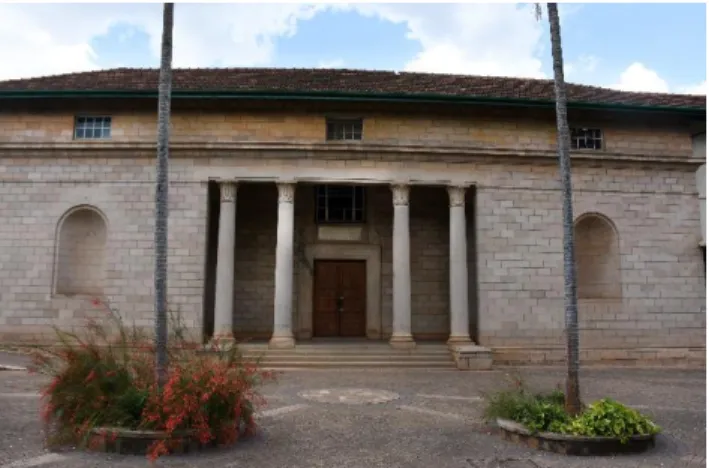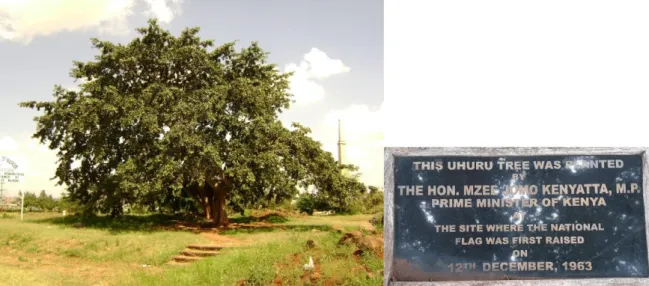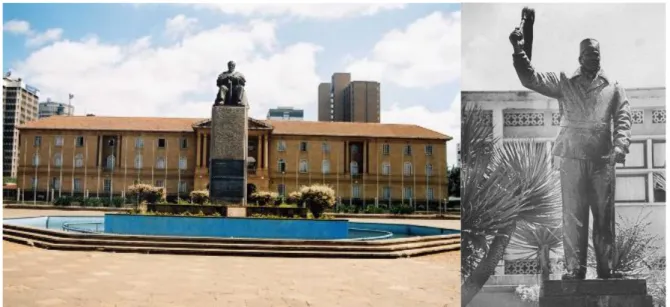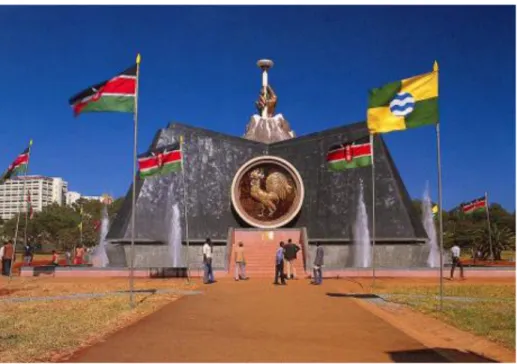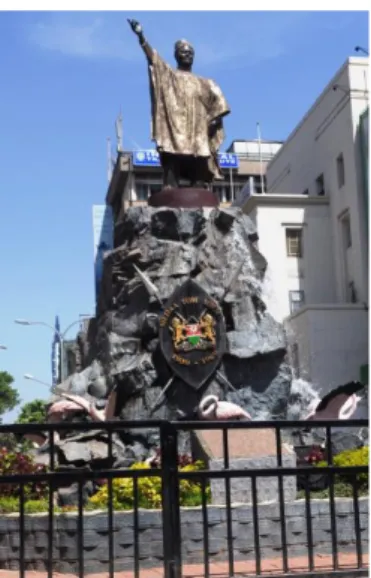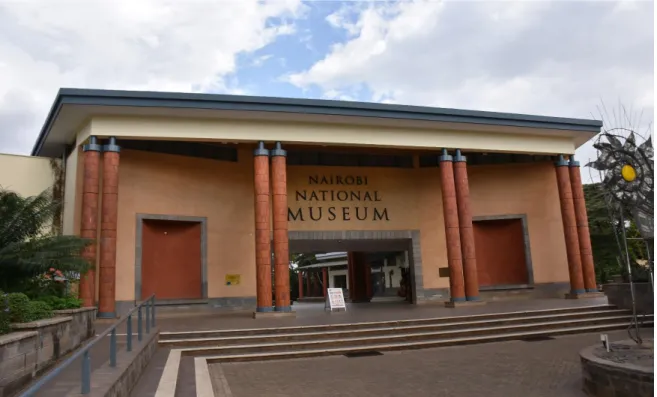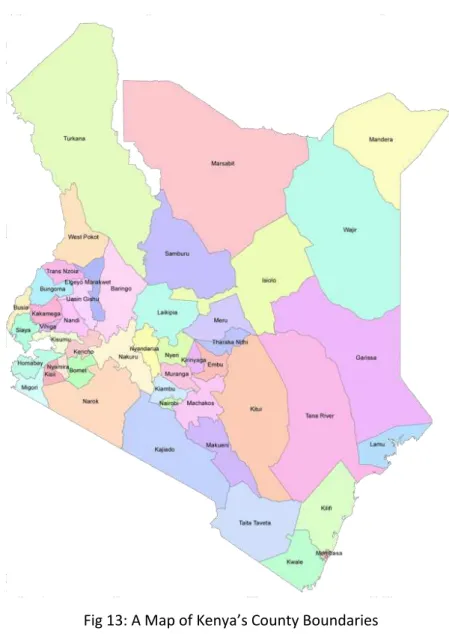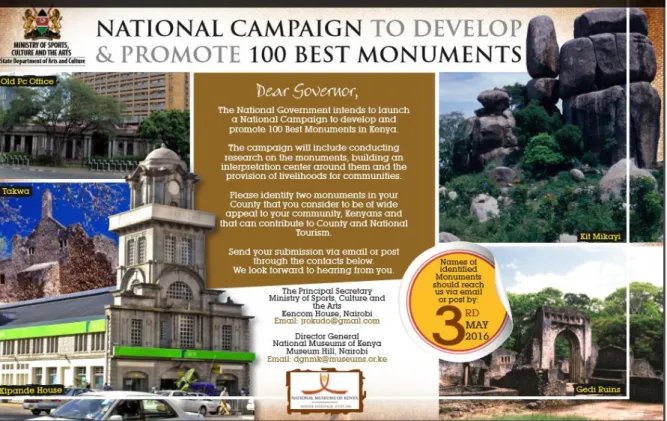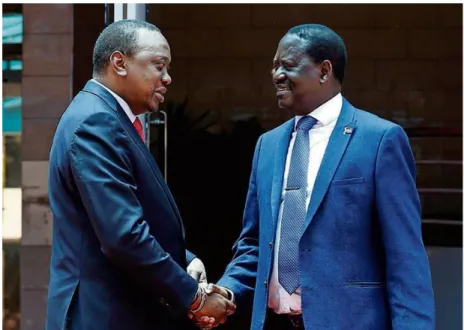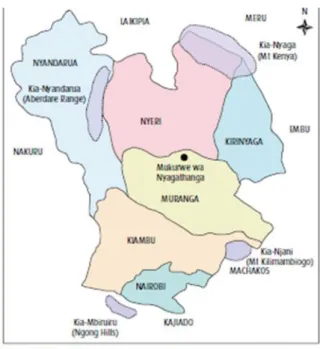HAL Id: tel-03134460
https://tel.archives-ouvertes.fr/tel-03134460
Submitted on 8 Feb 2021
HAL is a multi-disciplinary open access archive for the deposit and dissemination of sci-entific research documents, whether they are pub-lished or not. The documents may come from teaching and research institutions in France or abroad, or from public or private research centers.
L’archive ouverte pluridisciplinaire HAL, est destinée au dépôt et à la diffusion de documents scientifiques de niveau recherche, publiés ou non, émanant des établissements d’enseignement et de recherche français ou étrangers, des laboratoires publics ou privés.
wa Nyagathanga cultural site
David Mbuthia
To cite this version:
David Mbuthia. The challenge of negotiating between national and sub-national identities through heritage-making in post-devolution Kenya : with the example of Mukurwe wa Nyagathanga cultural site. History. Université de Pau et des Pays de l’Adour, 2020. English. �NNT : 2020PAUU1083�. �tel-03134460�
École doctorale 481 ITEM
Présentée et soutenue le 17 Décembre, 2020.
par David Irungu MBUTHIA
pour obtenir le grade de docteur
de l’Université de Pau et des Pays de l’Adour
Spécialité : Histoire
THE CHALLENGE OF NEGOTIATING BETWEEN NATIONAL AND SUB-NATIONAL
IDENTITIES THROUGH HERITAGE-MAKING IN POST-DEVOLUTION KENYA: WITH
THE EXAMPLE OF MUKURWE WA NYAGATHANGA CULTURAL SITE
NEGOCIER LES IDENTITES NATIONALE ET SOUS-NATIONALES, LA FABRIQUE DU
PATRIMOINE DANS
LE KENYA DE LA DECENTRALISATION: L’EXEMPLE DE SITE
CULTUREL DE MUKURWE WA NYAGATHANGA
MEMBRES DU JURY
RAPPORTEURS
• Susan Mwangi
Senior Lecturer, Kenyatta University
• Henri Médard
PR, Université Aix Marseille
EXAMINATEUR
• Herve Maupeu
MCF, UPPA
DIRECTEUR
i Declaration
I, David Irungu Mbuthia, declare that this Research Dissertation is my original work. Other works that have been quoted are duly acknowledged.
ii Dedication
This work is dedicated to my wife and children, without whose sacrifices and encouragement it would not have been possible. My wife Florence Waruinu Mwangi Irungu took up more than her fair share of domestic responsibilities during my lengthy academic sojourns in France, field work missions, and the innumerable times I worked late into the night. During these periods, our children Frank Mbuthia, Gracelyne Wangui, and Justin Mwangi were deprived of quality time and play with Daddy. I cannot remember how many times they asked the question, “Dad, when will you finish your work?” collectively and individually. My hope is that, as they continue to explore the world of knowledge, they will one day find the content of this thesis inspiring and worthwhile.
I also dedicate this work to my Mum and Dad, Jane Wangui and Francis Mbuthia, for instilling in me the love for education from childhood, and for their encouragement and moral support throughout this study.
Lastly, I dedicate this work to heritage managers in Kenya and beyond, with whom I have endeared to share my twenty years of experience in heritage management which straddles between pre and post-devolution eras. I hope they will find the work useful.
iii Acknowledgement
The attainment of this PhD is a dream come true for me. The motivation to undertake the research that culminated in its attainment was fuelled by a long standing interest in heritage and its conservation. My dream to earn a doctorate degree would, however, not have been possible without the help and intervention of many individuals and institutions that contributed in various ways. To these individuals and institutions, I owe much gratitude. Below I mention some of them.
First, I thank my supervisor Professor Christian Thibon, who guided and encouraged me throughout the long process of researching and writing, with a lot of insight and patience. I also thank Professor Jean Rieucau, and Christine Garnero Monera, both of whom gave me very helpful critique during the inception of this research. My gratitude also goes to Dr. Hérve Maupeu, Dr. Washington Ndiri, and Dr. Susan Mwangi who shared with me great insights at the formative stages of this research. I also thank Dr. Edwin Siundu who proof-read my final thesis and gave me invaluable editorial advice.
I would also like to thank the management of the National Museums of Kenya who allowed me to attend my ‘sandwich’ study sessions in France and undertake fieldwork in Kenya. I am particularly grateful to the Director General, Dr. Mzalendo Kibunjia; the Director in charge of Antiquities Sites and Monuments, Dr. Purity Kiura; the Director Human Resource and Administration, Mr Stanvas Ong’alo; the Head of Cultural Heritage Department, Dr. Joseph Mutanga, and the Corporation Secretary and Head of Legal Services, Ms Metrine Wakhungu. They all supported and facilitated my pursuit of the PhD in various ways including sharing their highly valuable insight regarding various aspects of heritage management in the country. I also thank Mr Fredrick Karanja Mirara, the former NMK’s Head of Education Department, who did not only introduce me to Mukurwe wa Nyagathanga in the early 2000s but was also very helpful when I reached to him on some points of clarifications during this research.
I would also like to thank my colleagues Njuguna Gichere and Antony Maina, and the senior heritage Warden Muriithi Kibaba, who accompanied and rendered me a helping hand during my field visits at Mukurwe wa Nyagathanga. Similar gratitude goes to another colleague, Julias Juma Ogega, who was my field assistant as I visited Kit Mikayi for a preliminary survey before I
iv
zeroed down on Mukurwe wa Nyagthanga as my case study. I also thank Ebrahim Mwangi from NMK’s Multimedia Department who, having documented the events at Mukurwe wa
Nyagathanga, was very kind to help me access and select images for this thesis. I thank Gilbert
Ouma Jerry who technically helped me adapt Łukasz Gaweł’s heritagization ‘Cobweb.’ My gratitude also go to Gilbert Busolo who, helped me recover a copy of my thesis when my flash disc crashed. I am also grateful to Mss Catherine Savali and Sheila Ambeyi who helped me with tracing back and aligning several references that I had misplaced. I also thank the NMK Library staff who were very helpful during the many days that I studied in the library.
My gratitude is also due to Marrion Kamau, the chairperson of the Green Belt Movement (GBM), who shared with me the background of the GBM’s involvement with Mukurwe wa Nyagathanga and further insights on how the site could be developed and safeguarded. I am also highly indebted to Professor Robert Rukwaro whose great insight I have benefitted from through the many discussions we have had in the course of this research and through his published work which formed part of my key readings for Mukurwe wa Nyagathanga. I am particularly grateful to him for allowing me to use his illustrations on the proposed renovation of Mukurwe wa
Nyagathanga.
My thanks also go to Anne Vourc’h, the Director of Réseau des Grands Sites de France, who received me at the ‘Grands Sites de France’ office in Paris, and shared with me insights on the work of the ‘Network of Grand Sites of France’organisation. I also thank Julie Boustingorry, the Architectural and Heritage Coordinator, Pau City, who elaborated to me how the regional heritage management system works in France. I am grateful to Vincent Guichard, the Director General of Bibracte Archaeological Site, who welcomed me to the site and to his home, where I shared great moments with his family. I am also very grateful to Mathieu Guerin, the Scientific and University Cooperation Attaché at the French Embassy, who at the very critical moment of writing this thesis, offered me succinct advice and encouragement that enabled me finalize the thesis in time. I am equally grateful to the French Government for sponsoring this study and to the French Institute for Research in Africa (IFRA), and Association of France Alumni in Kenya (AFRAKEN) for financing my field studies.
v
I am also grateful to my fellow students especially from Kenya (Kennedy Gitu, Wycliffe Nyachoti, Joseph Akuma, and Joyce Kaguta) with whom we encouraged each other.
Above all, I thank the almighty God, for the gift of life, good health, strength and the opportunity as I undertook this study.
vi
Abstract
Heritage-making, also known as heritagization, is the process by which various actors assign
different values to cultural identity based on specific interests. As a product of day-to-day living, heritage is created and recreated through perceptions and practices motivated by various reasons, which could be social, economic, or political. In Kenya, like in most African countries,
heritagization of culture has historically been used by ethnic and other sub-national groups in
the creation and maintenance of ethno-political, local, and regional identities. Heritagization has also been used by the state in the perpetual creation of Kenyan national identity and nation-statehood. Historically, the centrifugal forces that create ethno-political and local identities have been seen to pull against the centripetal force geared towards the creation of Kenyan national identity and nation-statehood.
Almost sixty years after independence, realization of a unitary Kenyan identity and nationhood has been hindered by perpetual ethnic politicization and state centralization instituted partly through identity instrumentalization and heritagization. While the origins of objectification, institutionalization and politicization of ethnicity, and centralisation of the state have been attributed to the colonial period, perpetual political heritagization of ethnic identity and state ethnicization by the political elite in the post-colonial period led to ethnic animosity which culminated with the 2007/08 Post-Election Violence (PEV). The desire and determination by Kenyans to imagine and ‘create’ a new Kenyan nation with equal opportunities for all led to the promulgation of a new constitution on August 27th, 2010. The constitution, which was premised
on devolution of power to the people was heralded as the concretization of a unitary Kenyan nationhood.
By recognizing “culture as the foundation of the nation and as the cumulative civilisation of the Kenyan people and nation (Art. 11), “the constitution promotes the concept of ‘Unity in diversity’, while safeguarding cultural or ethnic identities.” In the ten years that Kenyan devolution has been in place, the application of the “Unity in diversity” concept has proved to be paradoxical. On one hand the national government has variously attempted to use heritage for
vii
supposed creation of Kenyan nationhood and national identity. On the other hand, county governments and sub-national groups (ethnic, political religious) have continued to use cultural heritage for the creation of subnational (ethnic, religious, local and regional) identities.
This study analyses how different actors have continued to use cultural heritage to create and mobilise diverse ethno-political and regional identities against the Kenyan national identity and nationhood, whose creation has been an ongoing project of the state. The study also explores the possibility of having a balance and harmonious coexistence between the diverse ethno-regional identities and the Kenyan national identity in the context of devolution. In conclusion, the study emphasises the need for sound policies which would enable the achievement of such a balance for the common good of all Kenyans.
Key words: Kenya, Heritage-making, heritagization, ethnicity, nation-statehood, devolution
Résumé
La fabrique du patrimoine qui repose sur une, des patrimonialisations est le processus dans lequel divers acteurs attribuent des valeurs différentes à l’identité culturelle fondée sur des intérêts spécifiques. En tant que produit de la vie quotidienne, le patrimoine est créé et recréé aux travers des perceptions et des pratiques motivées par diverses raisons sociales, économiques ou politiques. Au Kenya, comme dans la plupart des pays africains, la patrimonialisation de la culture a toujours été utilisée par les groupes ethniques et autres composantes sous-nationales dans la création et le maintien d’identités ethno-politiques, locales et régionales. D’autre part, il a été utilisé par l’État dans la création perpétuelle de l’identité nationale kenyane et de l’État-Nation. Historiquement, les forces centrifuges qui créent des identités ethno-politiques et locales ont été vues pour s’opposer à la force centripète orientée vers la création de l’identité nationale kenyane et l’État-Nation.
Près de 60 ans après l’indépendance, la réalisation d’une identité et d’une nation kényane unitaires a été entravée par la politisation ethnique perpétuelle et la centralisation de l’État instituée en partie par l’instrumentalisation et la patrimonialisation identitaire. Si les origines de l’objectivation, de l’institutionnalisation et de la politisation de l’ethnicité et de la centralisation
viii
de l’État ont été attribuées à la période coloniale, la patrimonialisation politique perpétuelle de l’identité ethnique et de l’ethnicisation de l’État par l’élite politique dans la période postcoloniale a conduit à une animosité ethnique qui a culminé avec les violences post-électorales de 2007-2008. Le désir et la détermination des Kenyans d’imaginer et de « créer » une nouvelle nation kenyane avec des chances égales pour tous ont conduit à la promulgation d’une nouvelle constitution le 4 août 2010. La constitution, qui repose sur la dévolution du pouvoir au peuple, a été annoncée comme la concrétisation d’une nation kenyane unitaire.
En reconnaissant « la culture comme le fondement de la nation et comme la civilisation cumulative du peuple et de la nation kenyanes (Art. 11), la Constitution promeut le concept d'« unité dans la diversité », tout en préservant les identités culturelles ou ethniques. Au cours des dix années où la dévolution kenyane a été en place, l’application du concept « Unité dans la diversité » s’est avérée paradoxale. D’une part, le gouvernement national a diversement tenté d’utiliser le patrimoine pour la création supposée de la nation kenyane et de l’identité nationale. D’autre part, les gouvernements des Comtés et les groupes infranationaux (ethniques, religieux politiques) ont continué d’utiliser le patrimoine culturel pour la création d’identités infranationales (ethniques, religieuses, locales et régionales).
Au travers de l’étude de cas, cette étude analyse comment différents acteurs ont continué d’utiliser le patrimoine culturel pour créer et mobiliser diverses identités ethno-politiques et régionales contre l’identité nationale et la nation kenyane dont la création reste un projet en cours de l’État. L’étude explore également la possibilité d’avoir un équilibre et une coexistence harmonieuse entre les identités ethno-régionales et l’identité nationale du Kenya dans le contexte de la dévolution. En conclusion, l’étude souligne la nécessité de politiques saines qui permettraient la réalisation d’un tel équilibre pour le bien commun de tous les Kenyans.
Mot-Clés: Kenya, Fabrique-du-patrimoine, patrimonialisation, ethnicité, État-nation, decentralisation Heritage-making, heritagization, ethnicity, nation-statehood, devolution
ix
ACRONYMS AND ABBREVIATIONS
ACHPR – African Charter on Human and Peoples’ Rights ACHPR – African Commission on Human and Peoples’ Rights ACK – Anglican Church of Kenya
AHD – Authorized Heritage Discourse BBI – Building Bridges’ Initiative BIEA – British Institute in East Africa BoK – Bomas of Kenya
CAM – Commonwealth of Association of Museums CBK – Central Bank of Kenya
CBOs – Community Based Organizations CDF – Constituency Development Fund CEC – County Executive Committee CHS – Critical Heritage Studies
CIDP – County Integrated Development Plan CMK – Community Museums of Kenya CMS – Church Missionary Society CoK – Constitution of Kenya (2010) CPMs – Community Peace Museums CSO – Civil Society Organization CU – Catholic Union
DASM – Directorate of Antiquities, Sites and Monuments DMSM – Directorate of Museums, Sites and Monuments DP – Deputy President
DPFEA – Declaration of Principles of Freedom of Expression in Africa EABC – East African Broadcasting Corporation
EACC – Ethics and Anti-Corruption Commission EANHS – East Africa Natural History Society
EAUNHS – East Africa and Uganda Natural History Society ECK – Electoral Commission of Kenya
x
EU – European Union
FAO – Food and Agricultural Organization FGDs – Focused Group Discussions
FM – Frequency Modulation GBM – Green Belt Movement
GEMA – Gikuyu Embu Meru Association IBEAC – Imperial British East Africa Company ICC – International Criminal Court
ICCPR – International Covenant on Civil and Political Rights
ICESCR – International Covenant on Economic, Social and Cultural Rights ICH – Intangible Cultural Heritage
ICPC – International Centre for Policy and Conflict ICT – Information Communication Technology IDP – Internally Displaced People
IFRA – The French Institute for Research in Africa
IGRTC – Intergovernmental Relations Technical Committee ISS – Institute for Security Studies
IT – Information Technology
IUCN – International Union for Conservation of Nature
JOOUST – Jaramogi Oginga Odinga University of Science and Technology KADU – Kenya African Democratic Union
KAF – Kenya Air Force
KAMA – Kenya Anglican Men Association KAMATUSA – Kalenjin-Maasai-Turkana-Samburu KANU – Kenya African National Union
KATWA – Kavirondo Taxpayer’s Welfare Association KCA – Kikuyu Central Association
KCE – Kikuyu Council of Elders KDF – Kenya Defense Forces KeHA – Kenya Heritage Authority
xi
KENRICK – Kenyan Indigenous Knowledge Research Centre KFS – Kenya Forest Services
KICC – Kenyatta International Convention Centre KISA – Kikuyu Independent Schools Association KKEA – Kikuyu Karing’a Education Association KMRI – Kenya Marine Research Institute
KNATCOM – Kenya National Commission for UNESCO KoT – Kenyans on Twitter
KPU – Kenya People’s Union KTB – Kenya Tourism Board KWS – Kenya Wildlife Services KYA – Kavirondo Young Association
LAPPSSET – Lamu Port South Sudan-Ethiopia Transport LCEs – Luo Council Executives
MCA – Member for County Assembly MCC – Murang’a County Council MEGA – Meru Embu Gikuyu Association MIP – Museum Interactive Project MMRC – Mau Mau Research Centre
MOSCA – Ministry of Sports Culture and Arts MOSCH – Ministry of Sports Culture and Heritage MoU – Memorandum of Understanding MP – Member of Parliament
MwN – Mukurwe wa Nyagathanga
MWNKT – Mukurwe wa Nyagathanga Kihumo Trust
NARC – National Rainbow Coalition NASA – National Super Alliance
NCEOP – National Committee on Educational Objectives and Policies NCIC – National Cohesion and Integration Commission
xii
NGOs – Non-Governmental Organizations NMK – National Museums of Kenya
NMKSP – National Museums of Kenya Support Programme NPCH – National Policy on Cultural Heritage
ODM – Orange Democratic Movement OVCs – Orphaned and Vulnerable Children PCEA – Presbyterian Church of East Africa PEV – Post-Election Violence
PPMC – Permanent Presidential Music Commission SWOT – Strength, Weakness, Opportunities, and Threats TCEs – Traditional Cultural Expressions
TK – Traditional Knowledge
UDHR – Universal Declaration of Human Rights UHC – Universal Health Care
UK – United Kingdom UN – United Nations
UNESCO – United Nations Educational, Scientific and Cultural Organization UoN – University of Nairobi
US – United States
USA – United States of America
USIU – United States International University WIPO – World Intellectual Property Organization
xiii
List of Figures
Fig.1 Participants of a Focused Group Discussion at Mukurwe wa Nyagathanga 16 Fig.2 Statue of Lord Dalamere in Nairobi 52 Fig.3 Coryndon Museum Front View 54 Fig.4 King George V Statue being removed 58 Fig.5 The Mugumo tree planted by President Kenyatta at Uhuru Gardens 59 Fig.6 Kenyatta’s Statues outside KICC and Parliament Buildings 64 Fig.7 The 100 feet tall monument at Uhuru Gardens 72 Fig.8 Nyayo Monument at Central Park 73 Fig.9 Dedan Kimathi Statue in Nairobi 81 Fig.10 Tom Mboya Statue in Nairobi 82 Fig.11 New-Look Nairobi National Museum (NNM) 89 Fig.12 ‘EU’ Plaques at the NNM entrance 89 Fig.13 County Boundaries 95 Fig.14 Kenya’s 100 best Monuments Project Publicity 117 Fig.15 Kenyatta-Odinga Handshake 136 Fig.16 Location of Mukurwe wa Nyagathanga (MwN) 158 Fig.17 1998 MwN site survey 159 Fig.18 Nyumba (woman’s house) and Thingira (Man’s house) at MwN 159 Fig.19 Some of the Kikuyu’s daughters houses 150 Fig.20 Ruins of an intended tourist complex at MwN 150 Fig.21 Illustration of Interior components of Nyumba 164 Fig.22 Purification/Sin vomiting ritual 169 Fig.23 Mugo wa Kiburu Prophesy site in Thika town 170 Fig.24 Wangari Mathai Commemoration tree at MwN 177 Fig.25 Traces of Mungiki inscriptions at MwN 186 Fig.26 Njgenga Karume’s Coronation at MwN 189 Fig.27 Metallic gate at MwN 199 Fig.28 Members of Athinjiri Sect at Mukurwe wa Nyagathanga 202 Fig.29 A display of Kikuyu traditional items at Mukurwe wa Nyagathanga 203 Fig.30 Publicity for Church-based initiation for boys 207
xiv
Fig.31 Publicity for Church-based ‘initiation’ for boys and girls 207 Fig.32 Elders praying during a cleansing ceremony at MwN 217 Fig.33 Remains/Ashes from a burnt offering at MwN 218 Fig.34 Burning of Ritual Calabashes 219 Fig.35 Traditional demarcation/blessing of the MwN shrine 219 Fig. 36 preparing meat for feasting at MwN 220 Fig.37 Cultural dance entertainment at Mukurwe wa Nyagathaga 221 Fig.38 Artistic expression of proposed renovation of Mukurwe wa Nyagathanga 223 Fig.39 Proposed fortified gate for Mukurwe wa Nyagathanga 224 Fig.40 Proposed Kikuyu Cultural Centre at Mukurwe wa Nyagathanga 224 Fig.41 Heritagization ‘Cobweb’ at Mukurwe wa Nyagathanga 231 Fig.42 Murang’a County Logo with a Kikuyu saying as the Motto 233 Fig. 43 A burnt base of an indigenous tree at Mukurwe wa Nyagathanga 237 Fig. 44 Kikuyu elders at a newly ‘repossessed’ heritage site 244
xv
Table of Contents
Declaration……….. ..i Dedication ... ii Acknowledgement... iii Abstract ... vi Résumé ...viiACRONYMS AND ABBREVIATIONS ... ix
GENERAL INTRODUCTION TO THE STUDY ... 1
Thesis Outline ... 5
PART ONE CHAPTER ONE: RESEARCH DESIGN AND METHODOLOGY ... 8
1.1: Introduction ... 8
I.2: The Qualitative Research Approach ... 8
I.3: The Use of Case Study ... 11
I.4: Data Collection Methods ... 11
I.4.a: Interviews ... 12
I.4.b: Focused Group Discussion ... 15
I.4.c: Participant Observation ... 17
I.5: Fieldwork Challenges ... 25
I.6: Data analysis and Validity, Research Ethics and Limitations ... 26
1.7: Conclusion ... 28
CHAPTER TWO: THEORETICAL AND CONCEPTUAL FRAMEWORK ... 29
2.1: Introduction ... 29
2.2: Theorizing Ethnic Group, Nation, and Nation-State in the Kenyan Context ... 29
2.3: Theorizing Cultural Identities through Heritagization ... 36
2.4: Theorizing Heritagization in Post-Devolution Kenya ... 43
xvi
CHAPTER THREE: BACKGROUND TO CULTURAL HERITAGIZATION IN KENYA ... 48
3.1: Introduction ... 48
3.2: Precolonial Cultural Stewardship ... 48
3.3: Colonial Suppression and Subjugation of African Cultural Heritage ... 49
3.4: The Colonial Origins of the National Museums of Kenya and Kenya’s Heritage Policy ... 53
3.5: Post-Independence Nationhood- Craftsmanship, and Heritagization ... 57
3.6: NMK’s Belated Legal Reforms and Mandate Expnsion ... 76
3.7: Post-KANU ‘New Dawn’ in Kenya’s Heritagization ... 80
3.8: Conclusion ... 92
CHAPTER FOUR: POST-DEVOLUTION KENYANHOOD: BETWEEN UNIVERSALISM, MULTICULTURALISM AND ETHNICIZATION ... 94
4.1: Introduction ... 94
4.2: Establishing a National Kenyan Identity ... 94
4.3: Casting Kenyan Identity on a Multiculturalism Platform ... 99
4.4: Challenges of Devolving Cultural Heritage Management ... 104
4.5: Enacting Kenya’s National Identity in Post-Devolution Period: Some Controversies ... 112
4.5. a: Devolved National Celebrations or Ethno-political Contestations? ... 112
4.5.b: The Controversy around Nationalizing Kenya Currency’s Imagery ... 114
4.5. c: Kenya’s 100 Best Monuments Project: Stalled at the ‘intention’ Level ... 116
4.6: Conclusion ... 119
CHAPTER FIVE: POLITICAL INSTRUMENTALIZATION OF ETHNIC IDENTITY IN THE POST-DEVOLUTION ERA ... 120
5.1: Introduction ... 120
5.2: The Ethnic Factor in Kenya’s Political Competition ... 120
5.3: The 2013 Elections and the Emergence of Kenyatta-Ruto Pact ... 126
5.4: The 2017 Elections and the Kenyatta-Odinga ‘Handshake’... 132
5.5: Bringing the Luo Back into the Government through Kenyatta-Odinga ‘Handshake’ ... 137
5.6: Nyumba ya Mumbi Split between the Kenyatta-Ruto and Kenyatta-Odinga Pacts ... 142
5.7: Kenyatta-Odinga Pact and the Kalenjin Disillusionment ... 149
xvii PART TWO
CHAPTER SIX: REVISITING KIKUYU MYTH OF ORIGIN, IDENTITY AND SOCIO-CULTURAL
PRACTICES ... 158
6.1: Introduction ... 158
6.2: Colonialism, Christianity and their Disruption of Kikuyu Identity and Nationalism ... 171
6.3: Reference by Prominent Kikuyu’s and those in the Diaspora ... 176
6.4: Conclusion ... 178
CHAPTER SEVEN: MOBILIZING KIKUYU NATIONALISM IN SAFEGUARDING UTHAMAKI ... 180
7.1 Introduction ... 180
7.2: Post-Independence ‘latency’ in Kikuyu Nationalism ... 180
7.3: Jomo Kenyatta’s Arausal of Kikuyu Nationalism in Safeguarding of Uthamaki ... 181
7.4: Moi’s Suppression of Kikuyu Nationalism ... 183
7.5: Post-Moi Revival of Kikuyu Nationalism ... 186
7.6: Internal Competition for Control ... 188
7.7.a: Kikuyu Nationalism Evoked in Navigating the ICC Case ... 190
7.7 b: Sanctioning of ‘Traitors’ ... 193
7.7. c: The Kenyatta-Odinga ‘Handshake’ and its Dilemma for Kikuyu Nationalism ... 194
7.8: Conclusion ... 195
CHAPTER EIGHT: MUKURWE WA NYAGATHANGA AND THE HERITAGIZATION COBWEB ... 196
8.1: Introduction ... 196
8.2: The Complexity of Cultural Heritage ... 197
8.3 The Heritagization Cobweb at Mukurwe wa Nyagathanga ... 198
8.3. a: The KANU Elite Capture ... 198
8.3. b: The 2000s Revival of the Shrine and Subsequent Mistrust among Stakeholders ... 200
8.3. c: Internal Conflicts and Mistrust among Stakeholders ... 204
8.3. d: Conflict with some Churches ... 206
8.3. e: The Shrine as a Site for Power Struggles... 209
8.3. f: Post-Devolution Disillusionment ... 211
8. 3. g: Kenya’s 100 Best Monuments’ Project: the Dashed Hopes ... 214
xviii
8. 4 a: The Kikuyu Elders, Traditionalists, and politicians ... 232
8. 4. b: From Murang’a County Council to Murang’a County Government ... 232
8. 4. c: The National Museums of Kenya and the National Government ... 234
8. 4. d: Local Community ... 234
8. 4. e: The Green Belt Movement... 235
8.4.f: Mau Mau Research Centre ... 236
8. 4. g: Churches and Other Religious Groups ... 236
8. 4. h: Learners, Researchers, and Research Institutions ... 237
8. 4. j: Investors, Entepreneurs, and Tourists ... 238
8. 4. K: UNESCO’S Non-Involvement Problem? ... 238
8.5: Conclusion ... 240
CONCLUSION AND RECOMMENDATIONS ... 241
GENERAL INTRODUCTION TO THE STUDY
This introduction gives the general context of this study, which focuses on the challenge of negotiating between national and sub-national identities through heritage-making in post-devolution Kenya. The introduction then explains the research problem, hypotheses, goal and objectives of the study. The concept of heritagization, as used throughout the study is also introduced at this level. Finally, the introduction gives the general organization of this thesis which is divided into two main parts with a total of eight thematic chapters and a general conclusion with recommendations.
The study revolves around conceptualizing a Kenyan national identity, and Kenyan nation-statehood which have been contentious since independence. To conceptualize Kenyan national identity and nation-statehood, the study has considered both the primordial and the modernist theories. Under the primordial theoretical framework, such factors as common ancestry, culture, history and sense of communal solidarity are emphasised on as characteristics of a nation.1 In
this regard, a nation is perceived to consist of ethnically and culturally homogenous population inhabiting a given spatial territory. Going by this view, Kenya is cast as a country consisting of many ethnic nationalities2. This perception becomes applicable in the Kenyan case when one
considers how ethnic identity has continued to be reinvented and used to supposedly safeguard the various ethnic nationalities’ interests.
This study also uses the modernist theory in conceptualizing Kenyan national identity and nation-statehood. The modernist theory views the idea of the nation as an imagined political entity, whose creation depends on the ability of the citizens to imagine the nation.3 The modernist
1 Kellas, J.G. (1991) The Politics of Nationalism and Ethnicity. London: Macmillan. Kennedy, K.A.R. (1973) ‘Race and
culture.’ In R. Narroll and F. Narroll (eds) Main Currents in Cultural Anthropology, New York: Meredith Corporation pp. 25–56; Smith, AD 1994, ‘The Origins of Nations’ in Hutchinson, J and Smith A.D, Nationalism, Oxford, Oxford University Press; Smith, AD 1998, Nationalism and modernism, Routledge, London; Van den Berghe P., 1994, ‘A socio-Biological Perspective’ in Hutchinson, J and Smith A.D. Nationalism. Oxford: Oxford University Press;
Nationalities as Nation in a building process, a prehistory of the nation, a European concept to identify emerged new nation from Empire
2 Nationalities as Nation in a building process, a prehistory of the nation, a European concept to identify emerged
new nation from Empire.
3 Anderson B., 1991, Imagined communities, New Yok, Yale University Press; Gellner E., 2006, Nations and
nationalism, Blackwell Publishing, Oxford; HobsbawmHobsbawm EJ. 1994, ‘The nation as invented tradition’ in
2
theory emphasises the role of invention and reinvention of national traditions, memory, myths and symbols in creating a nation and giving its members a sense of a common (national) identity and destiny. According to Gellner4, the formation of a nation-state entails replacement of
different low cultures with a shared high culture to bring cultural and political congruence within the national territory. In viewing the Kenyan national identity and nation-statehood through the modernist theory, the study explores various initiatives that the Kenyan state has put in place in attempting to invent and reinvent a national culture, history and aspirations that would give all citizens a sense of common identity and destiny. Using the prism of the modernist theory, the study highlights the challenge that the country continues to grapple with when it comes to the realization of a unitary national identity.
After beginning with an assessment of various initiatives that have been used to create and promote a Kenyan identity and nation-statehood since independence, the study then explores the implications of the Kenya’s 2010 Constitution on the creation and promotion of Kenyan identity and nation-statehood. For this exploration, the study is pegged on the hypothesis that post-devolution promotion of Kenyan identity and nation-statehood in the context of the country’s cultural diversity has remained as paradoxical as ever before. This hypothesis is based on the thesis that while the 2010 Constitution of Kenya recognizing and endears to promote both ethno-regional and Kenyan-national identities, the reality of citizens’ identification with the Kenyan nation-statehood in post-devolution Kenya remains subjective to various mobilizing forces.
On one hand, the state has continued with its efforts to create and mobilize a Kenyan national culture and identity for the sake of national stability, social cohesion and peace-building. The mobilization by the state has been through various avenues including state controlled education system, language, media, technology, and cultural heritage policies. On the other hand, ethnic identities continue to be mobilized by the political elite in rallying their co-ethnics to protest any
Nationalism and Moral Regeneration’ in Hutchinson, J and Smith A.D, Nationalism,’ Oxford University Press, Oxford; Smith, AD 1994, ‘The Origins of Nations’ in Hutchinson, J and Smith A.D, Nationalism, Oxford, Oxford University Press
4Gellner E., 1994, ‘Nationalism and High Cultures’ in Hutchinson, J and Smith AD, Nationalism, Oxford University
3
real or perceived marginalisation or deprivation by the state, and to lay claim to various resources and land-linked rights. This mobilization has often been done through reinvention of cultural traditions and common identity in line with ethnic crystallization process elaborated by Smith5 and Brass6, among others. The subsequent ethnic crystallization has been seen to
threaten the stability and legitimacy of the state.7
Using the concept of heritage-making, also referred to as heritagization8, as well as case studies,
this study examines how cultural heritage has been continuously reinvented and mobilized by different actors to create and maintain both ethno-regional and national identities. It also ponders how a balance may be created between the ethno-regional identities and the Kenya national identity in the post devolution era. The concept of heritage-making and heritagization, in the context of this study, refers to the process in which cultural identity and heritage (including objects, places, practices and people) is constantly assigned and re-assigned different values by different actors for different purposes.
At the state level, heritagization is done to designate “official heritage” using a state-generated criteria in a process that has been referred to as Authorized Heritage Discourse (AHD) by Laura Jane Smith9. At sub-national level, heritagization is done by ethno-political, religious, local and
regional groups to designate values corresponding to, and for the purpose of promoting, the groups’ interests. The ‘unofficial’ heritage created by sub-national groups is often based on the groups’ subaltern narratives which are often in conflict or competition with the narratives represented by “Official heritage.” With the government having the power to choose which
5 Smith A.D., 1981. The Ethnic Revival in the Modern World. Cambridge: Cambridge University Press; Brass, P. R.
(1991). Ethnicity and Nationalism: Theory and comparison. CA, Sage Publications
6 Brass, P. R. (1991). Ethnicity and Nationalism: Theory and comparison. Sage Publications (CA).
7Lonsdale, J and Berman B., 1979, ”Coping with the Contradictions: The Development of the Colonial State in Kenya,
1895-1914”, The Journal of African History, Vol. 20, No. 4 White Presence and Power in Africa, pp. 487-505, Cambridge University Press, http://www.jstor.org/stable/181774; Berman BJ., 1998, ‘Ethnicity, Patronage and the African State: The Politics of Uncivil Nationalism’, African Affairs, Vol. 97, No. 388, July, pp. 305-341, Oxford University Press; Mamdani M., 1984, ‘Nationality Question in a Neo-Colony: A Historical Perspective’
Economic and Political Weekly, Vol. 19, No. 27 pp. 1046-1054, Economic and Political Weekly.
http://www.jstor.org/stable/4373383; Mamdani, M 2001b: When Victims Become Killers, Princeton, Princeton University Press.
8 Heritization translates two french concepts the patrimonialisation, perceptions and pratices about heritage
(monumental, hcitorical, cultural…) and the fabrique du patrimoine, policy making and poltics of heritage
4
heritage to promote and commemorate through national policy and state resources, most of the subaltern heritage remains suppressed with its promotion and commemoration largely relying on the passion, sentimental attachment and the goodwill of the groups it represents.
While reflecting on how cultural heritage and identity has been historically created and used by different entities over the years, this study sets out to establish how the Constitution of Kenya (2010), which ushered in devolution, has altered the use of ethno-cultural heritage by different players and how this has continued to impact on the formation and expression of Kenyan national identity and nation-statehood. The study also sets out to give recommendations on how harmonious balance between sub-national and national heritages and identities could be achieved. The study intends to answer the following questions: how has ethnic identity been historically instrumentalized and mobilized by different actors in Kenya? Has the 2010 devolution and its application posed any challenges or risks in terms of strengthening ethnic and regional identities and nationalisms at the expense of the Kenyan identity and nationalism? How could a harmonious balance between national and subnational identities be achieved?
This study sought to:
i. Understand how the government has continued with its efforts of creating and mobilizing a Kenyan national identity and heritage. To do so, the study has referred to the constitution as well as various government institutions, policies, programmes and activities related to the making and use of heritage. It has especially explored the work of the National Museums of Kenya (NMK) since its inception in the colonial era to its on-going realignment in the post-devolution era.
ii. Understand how different sub-national groups have continued to create and mobilise ethno-political and sub-national identities. To do so, the study has referred to the continued re-invention and mobilization of ethno-political traditions and practices by various sub-national groups.
iii. Explore the possibility of having a balanced and harmonious coexistence between national and sub-national identities in the country. To do so, the study has conducted an analysis of the Strength, Weakness, Opportunities, and Threats (SWOT) that the new
5
constitution and the socio-political atmosphere in which it is being implemented present to the achievement of such a balance.
Thesis Outline
This thesis is structured into two parts. Part One, which consists of five chapters presents the general context in which the creation and mobilization of ethnic and national heritages happens in Kenya. After the general introduction to the study which give the study’s contextual background, and objectives, the first chapter which establishes the research design and methodology used for the study follows. It gives the ontological and epistemological perspectives and the data collection and analysis methods employed. It positions the research within the field of Critical Heritage Studies (CHS), where it uses qualitative approach. The chapter also elaborates the professional connection of the researcher to the subject under inquiry.
The second chapter establishes theoretical and conceptual frameworks for the exploration of the formation and mobilization of ethnic and national identities in Kenya. Starting with a theoretical exploration of the concepts of ethnic group, nation and nation-state, the chapter then uses the concept of heritage-making or heritagization to scrutinize how cultural heritage has continued to be used in the formation and mobilization of ethnic or sub-national and national identities.
The third chapter gives a historical background to cultural heritagization in Kenya, beginning with the pre-colonial cultural stewardship to the colonial introduction of institutionalized heritage management and its evolution and use through the post-independence to post-devolution eras. The fourth chapter explores how the promulgation of Constitution of Kenya (2010) that seeks to promote both the national and ethnic/cultural identities simultaneously has had on the creation and promotion of the two identities by various actors including communities, as well as the county and national governments. Chapter Five investigates how political mobilization of ethnic identity has continued to impact Kenyan nationhood and national identity in the post-devolution era. It has evaluated the first two post-devolution elections to illustrate how the Kenyan political elite have continued to strategically use ethno-political mobilization to power and positions through intra-elite pacts which have little genuine regard for nationhood and promotion of national identity.
6
Part Two of the thesis, which consists of three chapters, uses the case study of Mukurwe wa
Nyagathanga cultural site to illustrate the practice of heritagization, political mobilization, and
interaction between ethnic and national identities on the ground. The first chapter in this part which is chapter number six in the thesis revisits Kikuyu ethnic identity by illustrating the centrality of Mukurwe wa Nyagathanga and the intangible heritage associated with it to Kikuyu ethnic identity. Chapter seven looks at how through Mukurwe wa Nyagathanga and the cultural traditions it embodies, Kikuyu ethnic identity has continued to be evoked and mobilised for socio-political reasons at both local and national levels.
Chapter eight explores how different meanings, values, interests, significances, perspectives, uses and activities associated with Mukurwe wa Nyagathanga by different stakeholders have continued to interact at the site and beyond, in the process of heritagization. The chapter also explores the different kinds of tensions, contestations and conflicts which happen among the stakeholders, and how this has affected the management of the heritage site and the process of invention, reinvention and mobilisation of ethnic, regional and national identity among the Kikuyu people. This chapter is followed by a general conclusion of the study, which is accompanied by recommendations.
7
PART ONE
This first part of the thesis presents the general context in which the creation and mobilization of ethnic and national heritages and identities happens in Kenya.
8
CHAPTER ONE: RESEARCH DESIGN AND METHODOLOGY
1.1: Introduction
This chapter elaborates the various aspects of research design and methodology that were used for this study, and why they were chosen. Some of the key considerations that were made while choosing a research methodology was that the challenge of negotiating between national and sub-national identities through heritage-making in Kenya is both historical and current; and is both a political and a heritage management issue involving many actors. Thus, the exploration of the study was posited in the context of Critical Heritage Studies (CHS), which is a relatively new interdisciplinary field of research that draws on various academic fields including history, political science, sociology, anthropology, biology, geography and art history.10 Basically, CHS is used to
investigate the processes of heritage-making or ‘heritagization’ through which heritage is created by both the state and socio-cultural groups. In this context CHS was used to investigate how Kenyan and ethnic identities and nationalisms have continued to be created and recreated as part of national and subaltern heritages. The rest of this chapter elaborates the various aspects of research perspectives that were adopted by this study.
I.2: The Qualitative Research Approach
This section begins by elaborating the ontological and epistemological perspectives that were adapted for this study. According to Crotty11, ontology is “the study of being.” Guba and Lincoln12
contend that ontology is about addressing the question “what is there that can be known?” and “What is the nature of reality?” Epistemology, on the other hand is defined by Crotty13as “a way
of understanding and explaining how we know what we know.” It provides “a philosophical grounding for deciding what kinds of knowledge are possible and how we can ensure that they are both adequate and legitimate14.”
10 Harrison R., 2013, Heritage: Critical approaches, New York, Routledge; Smith L., Uses of Heritage, London and
New York, Routledge
11 Crotty M., 2003, The Foundations of Social Research: Meaning and Perspectives in the Research Process,
London, Sage Publications, 3rd edition, p10.
12 Guba and Lincolin, 1989, Fourth Generation Evaluation, London, SAGE Publications, p.83. 13 Crotty M., 2003, The Foundations of Social Research p.3
14Maynard M., 1994, “Methods, practice and epistemology: The debate about feminism and Research,” In Manyard
9
There are two ontological perspectives. The first perspective views the reality in the world as being made up of social meanings, opinions, feelings and interpretations. Investigating the reality in such a world requires the use of various interpretive methods. The second ontological perspective holds that there are some given realities out there that are based on ‘cause and effect’ processes. Likewise there are two epistemological perspectives. The first epistemological perspective is constructionism that holds that all knowledge and reality is created in interactions between humans and between humans and their environment. Thus meaning is not out there to be discovered but is rather constructed. The second epistemological perspective is objectivism, which holds that meaning and knowledge exists out there awaiting to be discovered.
Research can either be qualitative or quantitative. While qualitative research is based on constructivism and focuses on ‘uncovering the meaning of a phenomenon,’ quantitative research is based on objectivism and focuses on finding out the cause-and-effect pattern of events15.
Merriam dictionary identifies four epistemological perspectives which recur in qualitative research namely; the positivist, interpretive, critical and postmodern perspectives. While positivist perspective “assumes that reality exists ‘out there’ and it is observable, stable, and measurable”, the constructivist or interpretive perspective “assumes that reality is socially constructed, that is, there is no single, observable reality”16.
The constructivist or interpretive perspective therefore aims at understanding, describing and interpreting a phenomenon which results into multiple context-dependent realities instead of seeking to establish a singular objective reality. According to Creswell, all social phenomena are interpreted through social constructivism in which “individuals develop subjective meanings of their experiences”… [which] … “are negotiated socially and historically”… “through interaction with others …”17 The social, cultural and political contexts and process in which multiple realities
are negotiated end up privileging one reality over other realities. The reality that is privileged is the one that belongs to the powerful in the society. To “critique and challenge” this power
15 Merriam S. B., 2009, Qualitative research: a guide to design and implementation, 2nd ed., Jossey-Bass, San
Francisco, p.5
16 Ibid p.8
17 Creswell, J.W. 2009, Research design: qualitative, quantitative, and mixed methods approaches, 3rd ed., Sage,
10
distribution, Critical Research design is engaged18. This leads to a postmodern perspective which
holds that among the multiple realities to any phenomenon, there is none that is more privileged than the other because they are all “nothing but myths or grand narratives,… which try to explain how things are in the world”19.
While some authors such as Wells20, view heritage conservation through a positivist perspective
which highly regards facts, truth and objectivity while viewing heritage objects to have intrinsic value, others such as Gibson and Pendlebury,21 and Smith22 view heritage management to rely on
constructivist and interpretive approach. This view is based on the fact that heritage values are cultural and social constructions. In seeking to understand how heritage-making was being practiced in Kenya by various actors, this study employed qualitative method using constructivist or interpretive perspective. This is because heritage and heritage-values are constructed and interpreted by humans during social interaction processes. The study also used critical perspective to understand power relations in heritage making in Kenya. The study hypothesizes that national and “official” heritage is made through various avenues including, the constitution, government policies, programs and activities. On the other hand sub-national or subaltern heritages are formed through (re)invention and mobilization of ethnic identities and practices. The study also sought to establish the power relations between the two forms of heritage.
The concepts of culture, heritage, identity, nationhood which are explored by this study are all products and processes of social interactions. As such, there are multiple perspectives regarding these concepts within the community. This research aims to capture the diverse perspectives as well as their interplay. To enable a deep understanding of these concepts and the challenge of nationhood and national identity creation in Kenya, this study used qualitative research
18 Merriam, S.B. 2009, Qualitative research p.10 19 Ibid
20 Wells, J.C. 2010, "Our history is not false: Perspectives from the revitalisation culture", International Journal of
Heritage Studies, vol. 16, no. 6, pp. 464-485.
21 Gibson, L. & Pendlebury, J. 2009, "Introduction: Valuing Historic Environments" in Gibson L. & Pendlebury J., (eds)
Valuing Historic Environments, Abingdon, Oxon, GBR, Ashgate Publishing Group, , pp. 1-16.
22 Smith, L. 2006, Uses of heritage; Smith, L. 2012, "Editorial", International Journal of Heritage Studies, vol. 18, no. 6,
11
approach. By using qualitative research method, the study was able to capture peoples’ personal experiences in their day to day interactions with each other and with the State in creating, recreating and expressing their culture, heritage and Identity.
Qualitative research also enabled the study to yield rich data in form of value-laden comments and statements. By getting people’s own interpretations and perceptions about heritage, identity and nationalism, the researcher was able to access and interrogate the social world in which these perceptions were developed. This is unlike quantitative research which would have yielded data in form of statistics, shedding less light on the social world in which human relations operate. According to Bryman23, Qualitative research enables the researcher to access people’s
personal experiences in regard to the phenomena being researched.
I.3: The Use of Case Study
Bryman24 argues that case studies enable both comprehensive and intensive analysis of a specific
case or unit, which enables the researcher to come up with explanations that could be generalized for similar situations. For a deeper understanding of political and socio-economic dynamics of ethnicity and state-building in the country, the study used the case study of heritagization of Mukurwe wa Nyagathanga cultural site. The site was selected based on its status as a definitive socio-cultural component of the Kikuyu identity whose mobilization in local and national politics has historically been very dynamic. The case study yielded in-depth understanding of the complexities involved in heritagization of culture in the formation of ethnic, local and national identities.The analysis done on the Mukurwe wa Nyagathanga site could be used for other heritage sites in the country. As indicate in the final conclusion, a comparative assessment was done with Kit Mikayi site, which established similar history and trends in the heritagization of the two sites.
I.4: Data Collection Methods
In choosing the data collection methods to use, the researcher considered the research questions that were being addressed, the kind of sample that was needed to address the
23 Bryman A., 2008, Social Research Methods, (3rd ed.) Oxford, Oxford University Press. 24 Ibid.
12
questions, as well as the kind of information that was hoped for. This study entailed data collection from both secondary and primary sources. Secondary sources are the ones that contain already interpreted data. For this study, they included such publications as book chapters, journal articles, as well as news and opinion analysis on the broad themes of ethnicity, nationhood and heritage management in Kenya. The publications were either accessed online or as printed copies. On the other hand, Primary data sources could either be written or oral. The written ones could include minutes of meetings, departmental and institutional reports, ethnographic reports, newspaper reports, diaries and letters which have not undergone interpretation. Through them, the researcher got firsthand knowledge and information of various events from those who had witnessed them. Arthur Marwick25 emphasizes on the
significance of the primary sources for reliability of a historical work.
For this study, the author accessed and studied various relevant reports, administrative documents and meetings’ minutes from the National Museums of Kenya as well Mukurwe wa
Nyagathanga management team. The author also reviewed and analysed video documentaries
and photographs related to Mukurwe wa Nyagathanga from the NMK’s audiovisual section. They included the video documentaries and photographs which were taken during a site cleansing ritual that was done in February 2017. Numerous newspaper articles and reports on the themes of ethnicity, ethnic conflicts, state-building, nationalism, elections, democratization, identity and heritage management in Kenya were also studied. Radio and television debates, as well as ‘new media’ productions such as You Tube videos, vlogs, blogs and podcasts were also consulted for information. The study also sourced information orally through interviews and Focused Group Discussions (FGDs) as explained below.
I.4.a: Interviews
Interviews were carried out with key informants from Murang’a County Government, the NMK headquarters, NMK’s Murang’a office, The Green Belt Movement, The University of Nairobi (UoN), Kenya National Commission (KNTCOM) for UNESCO in Nairobi, The State Department of Culture and the local community at Mukurwe wa Nyagathanga heritage site. For these
25 Marwick A., 2001, The New Nature of History: Knowledge, Evidence, Language. London, Oxford University Press, p.
13
interviews, informants were purposely selected based on the knowledge they were perceived to have regarding various aspects of cultural heritage and the context in which it was being managed.
The aim of the interviews with Murang’a County government was to investigate how well the county government was taking up the role of cultural heritage management as one of the functions that had been devolved by the 2010 constitution. The study sought to do this by investigating the framework that the county had put, or was putting in place in terms of cultural heritage policy, institutional and funding mechanisms. For this purpose, the County Executive Committee (CEC) Member, and the County Director in charge of heritage and culture were interviewed. This choice was based on their key role in making and implementing of policies on heritage and culture in the County.
At the NMK headquarters, The Director General, the Director in charge of Antiquities Sites and Monuments, The corporate Secretary and legal advisor, and the contact person for ‘Kenya’s 100 best monuments project’ were interviewed. These interviews aimed to gain a deeper insight regarding various aspects that were related to devolving of museums and cultural functions hitherto undertaken by the NMK to the counties. The interviews aimed to establish the policy, legal and institutional readjustments that the NMK was undertaking in compliance with the Consitution of Kenya (2010)’s requirement. The interviews also sought to understand the challenges and opportunities that emanated from the process of devolving cultural function to the counties. At the NMK’s Muran’ga office, the regional curator under whose regional mandate
Mukurwe wa Nyagathanga fell was interviewed with the aim of establishing the challenges and
opportunities he encountered working with the County government and community groups in the context of devolution.
At the Green Belt Movement, the chairperson was interviewed with the aim of getting a deeper insight of the GBM’s historical involvement with cultural heritage management and Mukurwe wa
Nyagathanga in particular. The interview also sought to establish the vision the organization had
14
school of Architecture, who had been involved in the activities of Mukurwe wa Nyagathanga since its gazettement and who had designed the site’s restoration plan was interviewed regarding the site’s development potential as well as the opportunities and challenges that its development faced. At KNATCOM, the director in charge of Culture, was interviewed. The interview sought to establish the interventions that KNATCOM or UNESCO was doing to contribute towards ensuring successful conservation of cultural heritage generally and Mukurwe
wa Nyagathanga particular in the context of devolution. At the Department of Culture, the
National Director of Culture was interviewed with the aim of establishing what the Department was doing to ensure smooth devolution of cultural functions to the county, as a way of safeguarding the country’s cultural diversity, national identity and social cohesion.
At Mukurwe wa Nyagathanga, the coordinator of the local management team was interviewed to establish the initiatives they had done or were doing to guide the local community’s participation in heritagization of ‘their’ cultural site. The interview also sought to establishe the challenges and opportunities they encountered in the process. Two seventy-year-old elders who were involved with the stewardship of the site was also interviewed. The elders were selected owing to their knowledge regarding the site and its associated intangible heritage. They were recommended for the interview by the members of the site management team. The elders gave useful information about the sites’ oral and life history. Bryman26 defines a life history interview
as the one in which the interviewee reflects on his/her and life history in details, while an oral history involves the interviewee narrating more specifically about some periods or events in the past.
Arthur Marwick27 and Jan Vansina28 make a distinction between oral history and oral traditions
by terming oral history as that history which has been passed down within the last 100 years, and oral traditions as information that is more than 100 years old. Bryman29 commends oral and life
history interviews for enabling the voices of marginalized groups to be heard. Accordingly, the two elders who were interviewed gave accounts of Mukurwe wa Nyagathanga from their life
26 Bryman A., 2008, Social Research Methods, (3rd ed.) Oxford, Oxford University Press. 27 Marwick A., 2001, The New Nature of History:
28 Vansina J., 1961, Oral tradition: a study in historical methodology. London, Routledge & Kegan Paul 29 Bryman, A., 2008, Social Research Methods, (3rd ed.)
15
experiences and memory (oral history) and also from what had been passed down to them from their forefathers (oral traditions and collective memory). The accounts they gave illustrated how deeply the local community valued the site and the dangers the site’s survival faced.
I.4.b: Focused Group Discussion
Focused Group Discussion (FGD) is a research technique in which a researcher brings together a group of individuals to discuss a particular topic with the aim of drawing data and information from the group members’ personal experiences, perceptions, beliefs and attitudes through an interaction that is moderated30. The technique has been used by psychologists and sociologists
since the 1940s31, but its popularity in such disciplines as education, communication studies,
health and marketing research grew in the 1990s32. As a research technique, FGD is similar to
interviews in that both techniques tend to reveal people’s values and perceptions.33 For this
reason some authors have confused the two techniques.34 However, the two techniques are
distinctive in that the researcher’s role and relationship with the participants is quite different depending on the technique used.35 In interviews, the researcher assumes the “investigator’s”
role and engages in one-on-one discussion with the participant, while in FGDs, the researcher assumes the role of a “moderator” or a “facilitator” moderating a discussion among a group of participants.
30 Morgan D. L., 1996, Focus Groups, Annual Review of Sociology, 22, 129–152; Israel B. A. et al., 1998, “Review of
Community-Based Research: Assessing Partnership Approaches to Improve Public Health”, Annual Review of
Public Health,Vol 19, Issue 1,
31Merton R. K. & Kendall P. L., 1946, “The focused interview,” American Journal of Sociology, 51, 541–557; Merton
R. K. et al., 1956, Focused Interview: A Manual of Problems and Procedures, 2nd ed, A division of Macmillan Inc, New York, NY, USA, The Free Press.
32Flores J. G. & Alonso C. G., 1995, “Using focus groups in educational research: Exploring teachers’
perspectives on educational change,” Evaluation Review, 19, 84–101; Lunt P. & Livingstone S., 1996, Focus groups in communication and media research. Journal of Communication, 42, 78–87; Szybillo G. & Berger R, 1979, “What advertising agencies think of focus groups,” Journal of Advertising Research, 19, 19–23; Wilkinson S., 1998, “Focus group methodology: A review”, International Journal of Social Research Methodology, 1, 181–203
33 Hargreaves D. H., 1967, Social relations in a secondary school, London, UK: Routledge; Mac an Ghaill, 1994, The
making of men: Masculinities, sexualities and schooling, Maidenhead, UK, Open University Press; Skeggs B., 1997, Formations of class & gender: Becoming respectable. Thousand Oaks, CA: Sage Publications Inc.
34 ParkerA. & Tritter J., 2006, “Focus group method and methodology: Current practice and recent debate”,
International Journal of Research & Method in Education, 29, 23–37.
35Smithson J., 2000, “Using and analysing focus groups: Limitations and possibilities,” International Journal of Social
16
Fig. 1: Participants of a Focused Group Discusion at Mukurwe wa Nyagathanga (Source: Author)
While the researcher’s role takes a center-stage in interviews, it is rather peripheral in FGDs36.
The advantages of FGD have been observed to include cost effectiveness37, and availing a forum
for different worldviews and perspectives.38 Its challenges include the tendency for group
members to digress from the Key topic of discussion. This requires the moderation of the researcher to keep the discussion on the right course. As a way of promoting courtesy and confidentiality, rules should be set to assure group members that whatever they say in the discussions will not be used against them39.
36 Hohenthal J et al., 2015, “Local assessment of changes in water-related ecosystem services and their
management: DPASER conceptual model and its application in Taita Hills, Kenya,” International Journal of
Biodiversity Science, Ecosystem Services & Management, Vol.11, pp.225–238; Kitzinger J., 1994, “The methodology
of Focus Groups: The importance of interaction between research participants” Sociology of Health and Illness, Vol 16, pp.103–121.
37Morgan D. L., 1996, “Focus Groups,” pp.129–152.
38 Guba E. G., & Lincoln Y. S., 1994, Competing paradigms in qualitative research, Thousand Oaks, CA, Sage
Publications Inc.
39Weillings K. et al, 2000, “Discomfot, Discord and Discontinuity as data: Using focused groups to researchsensitive
